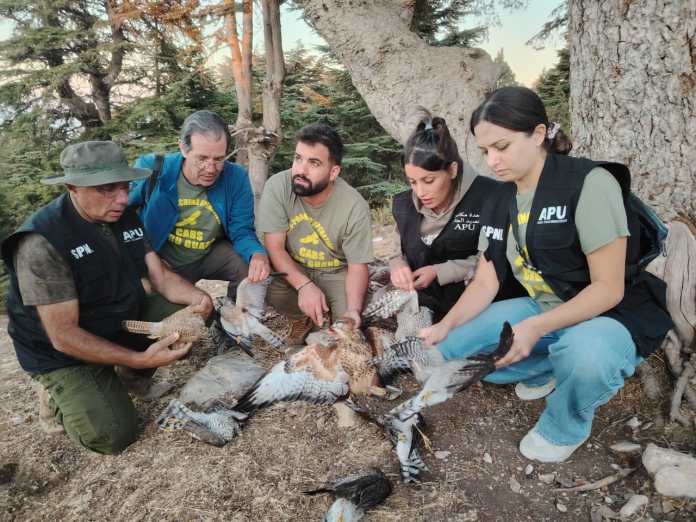Over a period of three days, patrols from the Joint Operations Team of the Anti-Poaching Unit conducted intensive monitoring, documentation, and intervention missions across several areas in North Lebanon. These operations took place during the peak migration season, a time when tens of thousands of birds of prey attempt to cross Lebanese skies on their way to breeding grounds in Africa. Tragically, this natural phenomenon has become a massacre, with poachers targeting the birds as they fly low over ridges and hilltops to catch thermals. Considered by some as a seasonal delicacy, the breast meat of these raptors has fueled an illegal and destructive practice that has spiraled out of control.
View this post on Instagram
In collaboration with the Internal Security Forces and local authorities, the patrols were able to document large-scale violations. At one of the most notorious hunting sites near Akkar, teams discovered shocking evidence of the slaughter: piles of feathers, wings, heads, and feet from more than 50 raptors, including honey buzzards, lesser spotted eagles, Levant sparrowhawks, hobbies, and kestrels. The remains were found scattered around a so-called “plucking site,” where poachers had not only killed the birds but also butchered them on the spot, grilling and eating them immediately after.
View this post on Instagram
The sheer scale of destruction was overwhelming—teams reported wading knee-deep through feathers while documenting the site. With video evidence and on-the-ground documentation, at least one poacher was identified and reported to the police, who, together with the security forces, took appropriate action.
These findings underscore the critical importance of the Anti-Poaching Unit’s work, which combines community vigilance, field enforcement, and scientific monitoring. They also highlight the urgent need for stronger enforcement of hunting laws, greater public awareness, and regional cooperation to stop the mass killing of migratory birds and preserve Lebanon’s role as a vital stopover on one of the world’s great flyways.






Field teams will continue to closely monitor several locations where trapping activity is expected in the coming days and weeks. This latest operation in Anfeh coincides with the autumn migration season and the launch of Lebanon’s annual bird protection camp.
International teams from the Committee Against Bird Slaughter (CABS) — including experts from the UK, Germany, and Turkey — are joining forces with the Society for the Protection of Nature in Lebanon (SPNL) and the Middle East Sustainable Hunting Center (MESHC). Together, and in close coordination with the ISF and the Lebanese Army, they are monitoring key migratory bottlenecks, investigating trapping hotspots, and disrupting illegal practices such as the use of nets and limesticks across mountain passes, coastal areas, and the Beqaa Valley.
About the Anti-Poaching Unit (APU)
The APU is jointly operated by MESHC and SPNL. It is supported by the Hans Wilsdorf Foundation, in collaboration with BirdLife International and in partnership with CABS. All operations are carried out in close coordination with Lebanese authorities, including the Internal Security Forces, the Intelligence and Investigations Branch, and Military Intelligence.
Part of the BioConnect Project
The work of the APU also contributes to the BioConnect Project — a 45-month initiative running through October 2025. BioConnect aims to:
-
Improve management and governance of ecologically important sites
-
Establish new protected areas and other effective area-based conservation measures (OECMs)
-
Enhance conservation across landscapes while restoring ecosystem health
-
Deliver socio-economic benefits and support local communities by addressing drivers of biodiversity loss






